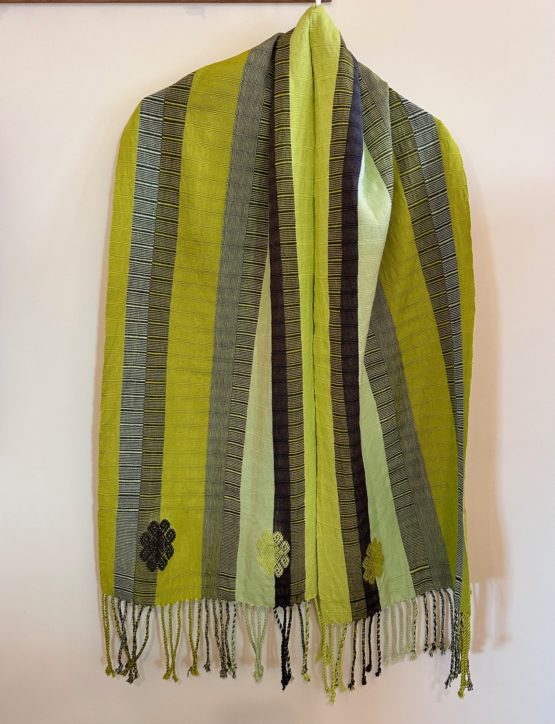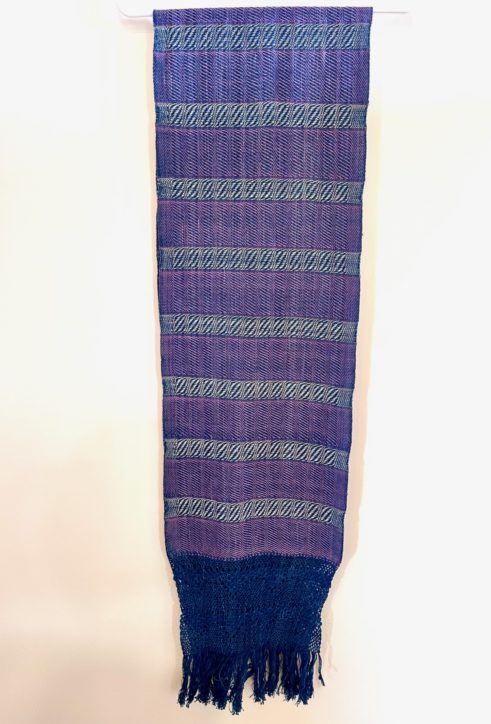I served the nicuatole recipe I made and published last week to my Zapotec friend Janet. She said it was good, very good, but it wasn’t the traditional nicuatole recipe she was used to eating here in Teotitlan del Valle. The traditional cooks of Oaxaca use white corn, not comal (griddle) toasted and ground yellow corn, like I used. I confess, it’s what I had on hand for the cornbread and I didn’t know the difference until now!
Hence, Recipe Redux.

December 12 is the feast day for the Virgin of Guadalupe in Mexico. I’m celebrating Lupita by going to a Virgin Play Day, where a bunch of us will make something related to the pre-Hispanic Goddess of Corn who is the syncretic icon more popular than the Virgin Mary or Jesus. I want to bring nicuatole to contribute to the potluck and I want it to be just like its pre-Hispanic origins.

This is a dessert I’m fond of for many reasons. It is corn. That means, it’s gluten free. I use almond milk instead of cow milk. That means it’s dairy free. (I imagine one can also substitute other nut and plant milks, too, but I think coconut milk will give a distinct flavor that will alter the taste.) This dessert is comforting, creamy, like pudding, eaten with a spoon it is almost like a mousse.
In my research, I could not find a specific recipe for a white corn nicuatole. So, I watched some videos that came up in the search — all in Spanish, and all with no measurements of ingredients provided! Traditional cooks here make food like their mothers and grandmothers — by touch, sight and consistency. Great, but not good enough for the precision we need in the USA.

Receta de Nicuatole de Maiz Blanco — Las Delicias Lupita, this is a high-calorie treat that uses whole milk and condensed sweetened milk. As we would say here, muy rico. This is fun to watch to see how great food comes from humble kitchens. No measurements. I made up the recipe below from just watching and from making the previous recipe. Here, I’ve added specific measurements.
Norma’s Nicuatole Ingredients
- 2 cups white corn, ground fine
- 4 cups of water
- 1 cup of almond milk
- 1/2 to 3/4 cups of white cane sugar
- 4 pieces of stick cinnamon, broken or 1/4 t. ground cinnamon
- 2 T. sugar colored with red food coloring
Directions:
Combine 2 cups of cornmeal and 3 cups of water in a blender and process mixture until smooth.

Note: I bought whole kernel, organic white corn that had been dried, from a puesto (stand) in the Teotitlan del Valle village market. One kilo. I’m certain it was grown on local land by her family. I then took the corn to my corner molino (mill) where the kernels were ground into a fine meal. I told them I wanted it to make atole!

Pour water/corn mixture through cheesecloth or a fine sieve to filter out any large corn particles. If you buy commercially prepared cornmeal, you probably won’t need to do this step.
Pour filtered liquid into stainless steel saucepan or heavy clay cooking pot. Put pot over a heat diffuser and turn heat to medium. Add remaining liquid and stir. Add sugar. Stir. Add cinnamon. Stir. Cook over medium heat, stirring occasionally for the first 15 minutes. Turn heat to low, and then stir constantly for the remaining 30 minutes (45 minutes cooking time total). I set my timer to stir every 5-7 minutes until the last 10 minutes of cooking time, making sure the bottom doesn’t stick to pot.

Mixture will become the consistency of heavy cream, then thicken to a consistency of heavy porridge like Cream of Wheat. When you stir and see the bottom of the pan, you know it is done. Watch the video to see the proper consistency.
Pour the hot corn mix into a square pan. Let it cool. Top with colored sugar and refrigerate. Prepare 12-24 hours in advance to chill sufficiently so that it is firm and easy to cut into squares.
Serves 8-12, depending on portion size.
Here is another nicuatole video to tickle your taste buds for a smaller batch, but it uses GMO corn. Substitute organic.
It’s December 11 and almost 9:00 p.m. in Teotitlan del Valle as I write this. The cojetes (firecrackers) have started. There is a full moon, the last of the year. On December 12, the Dance of the Feather, Los Danzantes de la Pluma, will honor the Virgin of Guadalupe in the church courtyard. Take a taxi and come on out to join the festivities. Maybe there will be nicuatole, too.



































































Pre-Hispanic Oaxaca Cooking Class with Vicky Hernandez
High up the hill in the shadow of Oaxaca’s famed archeological site of Monte Alban is a humble comedor on a dirt side street down the hillside from a paved access road. Carefully make your way down a curved, steep stairway cut into the hill to find the simple kitchen of Cocina Pre-Hispanica con Fogon where Vicky Hernandez teaches about the origin of Oaxaca food. Simple yet complex, organic and healthy, flavorful and rich with tradition.
Carol, who has known Vicky for years, arranged this cooking class for her daughter and her daughter’s fella. I tagged along. While I used to own a gourmet cookware shop and cooking school, there is always more to learn, especially about the roots of Oaxaca food. Moreover, I remember meeting Vicky six years ago when she taught her first cooking class in Carol and David’s miniscule kitchen on Huzares.
First, what is a FOGON? This is the adobe mud table-height cooking stove fueled by wood and topped with a clay comal (griddle) that is nixtamalicized (coated with white calc so the corn doesn’t stick).
We start the morning at 8 a.m. Vicky picks us up in the Historic Center where Carol lives, hiring two taxis to ferry the four of us and her to Abastos Market first to do the shopping. Central de Abastos is one of the largest market in Mesoamerica. It is a maze, a warren, a hub of everything Oaxaca — food, drink, pottery, clothing, animals and feed. The uninitiated can get lost — easily. It is best to follow an expert like Vicky, who led us to her favorite organic vendors.
On the cooking class menu today are memelas, sopa de guias, quesadillas with squash blossoms, chicken with mole rojo, atole — all traditional pre-Hispanic foods. So we gather ingredients, wending our way through narrow aisles just as the market vendors start to set up shop. The bustling begins.
We are like ducklings and somehow, we end up on the other side of the market only to exit to find the taxis waiting for us on the street. We climb in and begin the drive up the winding Monte Alban hill.
The day is starting to heat up but the hillside shade keeps us cool. We start off with traditional sweet bread to dunk into a cup of steaming cafe de olla (sweetened coffee flavored with cinnamon). On the table are plump cobs representing different pre-Hispanic colors of corn. Vicky asks Becky to choose which color corn to use for the memelas, and Becky points to the red.
Vicky puts the corn kernels into a pot on the charcoal burner and adds calc. Corn needs human intervention to eat. The corn soaked and cooked in calc will soften the hard protective shell, making it edible. Then, the grinding begins. For speed, Vicky uses an untraditional hand-cranked grinder instead of a metate (original stone grinding platform).
We learn that corn soaked in ash is used for corn beverages like atole and tejate, while corn soaked in calc is used for food preparation. We learn that pre-Hispanic cooking translates to using only natural materials: clay, wood, calc and ash, and native plants.
The memelas are the best I’ve eaten, smeared with bean paste and topped with Oaxaca queso fresco (the crumbly local cheese). The corn base is shaped into a huarache (a shoe). The native red corn turns blue in the cooking. It is crunchy, nutty, filled with flavor. Corn and beans combined are an excellent protein source.
For the sopa de guias — squash vine soup — three local herbs are needed: chipil, chipiche and piohito. The base is water to which is added small round squashes called calabacitas that are quartered, squash blossoms (remove the stamens), shredded squash vine leaves, and 2” cut sections of the vine (thick outer strings removed like you do with celery stalks). Nothing of the plant goes to waste. We set about stripping the leaves and flowers from the chipil stalks, careful not to add the seed pods.
Next comes the herb epazote. This very aromatic green is used to flavor beans and squash blossom quesadillas. We use quesillo for this, the Oaxaca string cheese. Don’t be skimpy with the cheese! Vicky tells us epazote is also used as a tea to kill parasites and to eliminate gas and bloating when added to beans during cooking. She a scrambled egg sandwich with epazote and chopped onions is the best.
The mole rojo, the red sauce for the chicken, is started by cooking together roasted, skinned organic tomatoes and two tablespoons of vegetable oil, then adding two cups of chicken broth. Once this is combined and cooked, we add about one cup of mole paste Vicky bought in the market earlier. Later, we eat this slathered over a piece of cooked chicken, scooping up the sauce with pieces of tortilla. Yum.
Kitchen accoutrements are basic: a molcajete to make the salsas, a metate to grind the corn or cacao, a clay olla or cooking pot, a comal (griddle) on which to cook the tortillas. For the salsa to accompany the Sopa de Guias, Vicky puts sliced onion, lime juice, salt and chiles de agua in the molcajete her father made 50 years ago, smashing all the ingredients together. Aromatic and flavorful. If you can’t find chile de agua, you can substitute jalapeño or serrano chiles.
We sit to eat at a table in the humble comedor with views of the mountain above and the city below. The sun is shining and we are satisfied. At the entry, Vicky’s mother prepares an order for customers at the next table. I sip the hot atole. It is the best I’ve ever had, a rich corn liquid punctuated with small particles of floating corn. I ask to take home the corn residue left after squeezing the liquid through the gauze cloth. I’ll use this to add crunch to my homemade, gluten-free biscotti. In Italy, the residue is what makes polenta. Mexico, the source of corn, provides sustenance around the world.
When we finish, we walk to the crossroads a short distance from the comedor and hop on a new Oaxaca city bus that takes us back to the zocalo in the historic center I. 20 minutes. Cost: 8 pesos or 40 cents.
Note: Class is taught in Spanish. If you need translation, Vicky can arrange for a translator to be there with you.
How to find Vicky Hernandez:
Telephone: 52-951-396-2621
email: vickyher70@gmail.com
Instagram: cocinaprehispanica
Reserve class with linktree — linktr.ee/cocinaprehispanicaoaxaca
Website: cocinaprehispanicaenfogon.com
Cost: $1,800 pesos per person cash for a 5-hour experience
Highly recommend for great food and culinary education.
Like this:
10 Comments
Posted in Cultural Commentary, Dining and Lodging, Oaxaca Mexico art and culture
Tagged Cocina Pre-Hispánica en Fogon, cooking, cooking class, food, Mexico, Monte Alban, Oaxaca, pre-Hispanic, tourism, traditional kitchen, travel, Vicki Hernandez